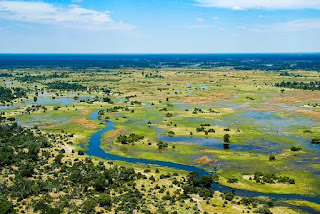The Okavango Delta is a unique inland river delta located in northern Botswana, Southern Africa. It is one of the largest and most diverse ecosystems in Africa and is considered a UNESCO World Heritage Site.
The delta is formed by the Okavango River, which originates in the highlands of Angola and then spreads out over the flat Kalahari Desert, creating a vast network of channels, lagoons, and islands. It covers an area of approximately 15,000 square kilometers (5,800 square miles) during the peak flood season.
The Okavango Delta is known for its exceptional biodiversity and is home to a wide variety of plants, animals, and bird species. The wetland environment supports an abundance of wildlife, including elephants, lions, leopards, cheetahs, hippos, crocodiles, zebras, giraffes, and numerous antelope species.
One of the unique aspects of the Okavango Delta is that it is a year-round oasis in the midst of the Kalahari Desert. The delta's floodwaters arrive from the Angola highlands between March and June, creating a spectacular phenomenon known as the "flood season." This annual flooding not only sustains the ecosystem but also attracts large numbers of migratory birds and provides excellent conditions for water-based activities such as boating, canoeing, and fishing.
The delta is a popular tourist destination for nature enthusiasts and offers a range of safari experiences. Visitors can explore the delta's channels and islands on guided mokoro (traditional dugout canoe) excursions, take game drives to spot wildlife, go on walking safaris, or stay at luxury lodges and camps located within the delta.
In recent years, efforts have been made to conserve the Okavango Delta and protect its fragile ecosystem. Sustainable tourism practices and community-based conservation initiatives play a vital role in preserving this unique natural wonder for future generations.


No comments:
Post a Comment